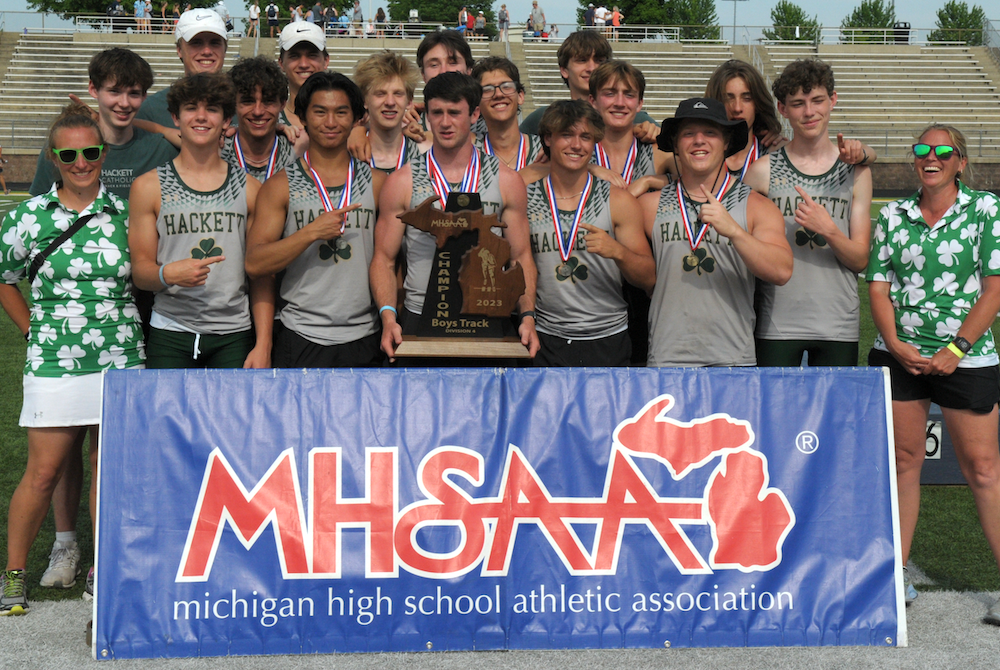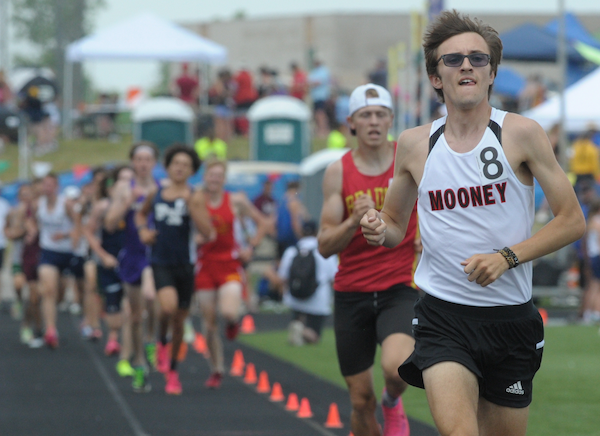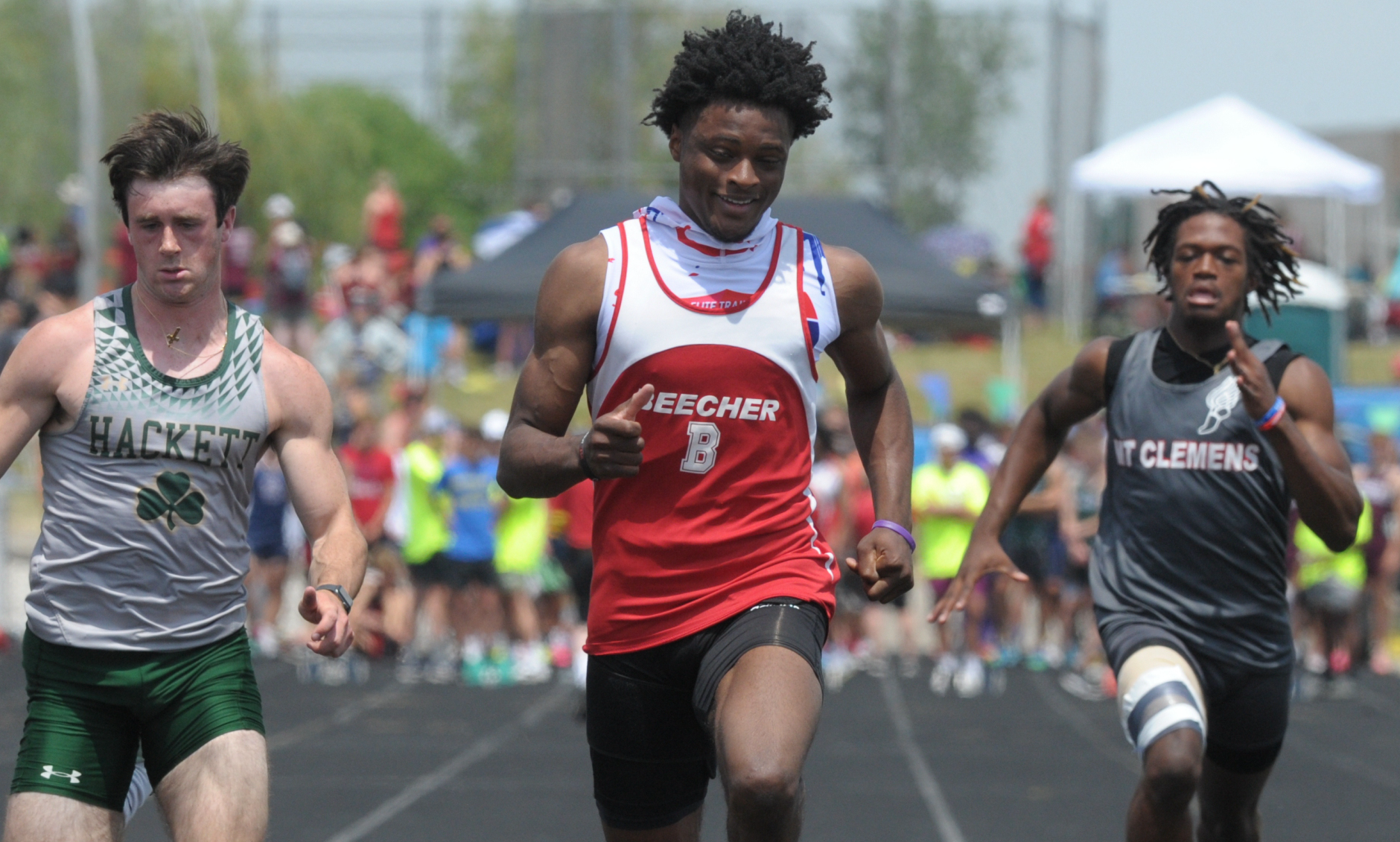
Field Events Push Gladstone Back To No. 1
By
John Vrancic
Special for MHSAA.com
June 2, 2013
KINGSFORD — The grandstand was nearly full at Kingsford's Flivver Field on Saturday. But probably not many people witnessed the work in the field events by the Gladstone boys during the Upper Peninsula Division 1 Track and Field Finals.
Gladstone, which scored 69 points in the field events, finished with 112 for its seventh U.P. championship in 10 years.
The Braves were followed by Menominee 80, Kingsford 73 and three-time defending champ Marquette 61.
"I couldn't be more proud of these kids," said Gladstone athletic director/assistant coach Matt Houle. "They were prepared, confident and ready to go. All the kids stepped up in the field events. We had to dominate those to win the meet. We took control in the field, and the guys in the running events took care of business."
Houle filled in for head coach Gary Whitmer, who suffered a broken sternum in an automobile accident Friday morning.
Senior Jared Vuksan set the U.P. D-1 shot put record at 55 feet, 11¼ inches, topping the previous best (52-1/2) by Braves' now-volunteer assistant coach Kent King three years ago.
 Vuksan, who will play football at Northern Michigan University this fall, also won discus in a school--record toss of 153-2¾, placed fourth in long jump (18-4) and helped the Braves take third in the 400-meter relay.
Vuksan, who will play football at Northern Michigan University this fall, also won discus in a school--record toss of 153-2¾, placed fourth in long jump (18-4) and helped the Braves take third in the 400-meter relay.
"My release was a lot better today in disc," Vuksan said. "I evened out my throw, and the disc came out flatter.
"I got the U.P. record in shot on my last throw. I stayed low and my footwork was good. My first throw was 50-5 and I think that set the tone. I really got pumped for the last throw. That was a great way to finish."
Classmate Justin Pederson added firsts in high jump (6-3) and long jump (21-½) and was runner-up in the 100-meter dash in 11.31 seconds.
Kingsford junior Cole Tengesdahl won the 100 (11.26).
"I'm a little disappointed in my 100, although I have to take my hat off to Cole," said Pederson, who plans to run track at Michigan State as a walk-on next year. "In high jump, everyone went out after six feet and I kept going. There was a lot of pressure, but I seem to do better in that situation. After I cleared 6-3, I went up to 6-5 and nicked the bar on my way down.
"My goal in long jump was just to break 21. I just tried to stay consistent."
Junior Chris Sedenquist added a victory in the 400 at 51.39.
Menominee had a triple-winner in senior Bryan Hines, who took the 110 hurdles (15.96) and 300 (41.59) and helped the winning 400 relay.
Sault Ste. Marie freshman Parker Scott, hindered by a foot injury much of this season, won the 800 (2:00.9) and 1,600 (4:31.98). He was the U.P. cross country champion in his division last fall.
PHOTOS: (Top) Gladstone senior Justin Pederson completes a high jump on the way to finishing first with a leap of 6-3. (Middle) The Braves' Jared Vuksan added a fourth place in long jump to his championships in the discus and shot put. (Photos by Eric Thompson; click to see more Gladstone photos at www.ericthompson.smugmug.com.)

Thrower Claims Lone Individual Title to Lead Hackett to Team 3-Peat
By
Tom Lang
Special for MHSAA.com
June 3, 2023
Kalamazoo Hackett Catholic Prep just keeps winning and winning.
This time the Irish took home their fourth title in the last five Lower Peninsula Division 4 Track & Field Finals, on Saturday at Hudsonville.
Hackett’s only individual title was taken by discus winner Nathan Buchmann, a senior, who was fine knowing he was the shortest in stature among all the sizable competitors.
“In the offseason after football I worked out every day, working towards this goal,” he said after getting his medal. “I would say this takes 80 percent technique and 20 percent strength to throw the discus. So, length can help but if you have good technique and are really strong, that will play into it.
“I think we are very balanced throughout the meet today,” he said about teammates that scored points in finishes other than first place. “We have 13 guys here today, and we have people in a lot of the races. But I do not run; I have too short of legs to be a fast runner,” he said with a chuckle.
Buchmann had to work through a hip injury to compete this spring.
“I think the setbacks are what make you strong,” he said. “You can either give up through the setbacks or push forward and become better.”
 Coach Charissa Dean agreed.
Coach Charissa Dean agreed.
“The kids have big hearts,” she said after all the points were totaled and the Irish were on top once again, with 53. “They worked hard. They had a lot of potential when we started the season. And we had a lot of drive to put in the work, and we are happy the results came out the way they did.”
Reading was runner-up at 47 points, followed by Wyoming Potter’s House Christian with 42, then Fowler and Flint Beecher each with 37 points.
Senior Lezawe “Moses” Osterink, of Potter’s House Christian, placed second in 1,600 but took the 3,200 title as defending champ of both. He dominated the latter by lapping the field with a final lap kick that resembled more of a superhero speedster.
“Nobody really took it out that hard at the start,” he said. “There was a freshman (Marek Butkiewicz of Hackett) that tried to get the pace going quick, but me and Dakota (Dykhuis of Montabella) just kind of sat back and gradually pulled him through.
“We took it gradually, and I was just relying that I could kick.”
Kick did he ever. The trio were neck and neck the majority of the race in a grouping ahead of the pack.
“With 400 to go I just tried to go all out,” Osterink said. “I had a lot more left than I thought and I was pleased with the win. Not really the time, but that doesn’t matter, especially this hot out.”
The overall meet was in the low 90s/high 80s heat and searing sun all day. So, race officials allowed the unique opportunity for coaches to spray the runners with water and give them water bottles.
“It was very weird because I’ve never taken water to drink while I’m running, so I didn’t know how that would feel,” Osterink said. “And they were spraying us and hitting us in the face. It was kind of fun.”
Junior Tyler Lenn of Marine City Cardinal Mooney defeated Osterink at his own game in the 1,600.
“I’m feeling great,” Lenn said after grabbing the medal. “I said to a newspaper after one of my races (during the season) I was right where I wanted to be. This has been a long rebuilding process for me since an injury back in the fall, and I set a pretty high goal the day the injury happened. I was telling myself I needed to fulfill what I said I would do at the beginning of last cross country season. And that is what I did today.”
Lenn suffered an ankle sprain from a misstep that turned worse because he kept running through the season on it.
“Coming back from that was pretty tough, but I wouldn’t have it any other way,” he said.  “Perseverance; I said from the beginning what I was going to do. I kept my eye on that target, and no matter the circumstances life threw at me, that I was going to make it happen and I am a man of my word.”
“Perseverance; I said from the beginning what I was going to do. I kept my eye on that target, and no matter the circumstances life threw at me, that I was going to make it happen and I am a man of my word.”
Jaylin Townsend, a senior from Flint Beecher, dominated the short races. He won the 100 dash (10.67) and 200 dash at 22 seconds flat. It was his third 100 win at a Finals.
“I put in a lot of work; I had to three-peat,” he said after the 100. “There’s a lot of great competition here, so I knew I had to come out and run my best.”
Concord in the 400 (43.72), Buckley in the 800 (1:30.76) and 1,600 (3:29.13) and Potter’s House in the 3,200 (8:14.18) were relay champs Saturday. Reading’s Tayshawn Bester won the 110 hurdles (15.13), and Athens’ Landen Bennett won the 300 (39.85). Caseville’s Nathan Feltner won the 400 (50.76), and Vestaburg’s Owen Patton claimed the 800 (1:55.11).
Fruitport Calvary Christian’s Bradley Richards won the high jump (6-10), and Peck’s Alex Affer won the long jump (23-4). McBain Northern Michigan Christian’s Isaac Bowden was first in pole vault (13-0), and Brown City’s Kyle Affer won shot put (49-2).
PHOTOS (Top) Kalamazoo Hackett Catholic Prep celebrates its third-straight LPD4 title Saturday. (Middle) Cardinal Mooney's Tyler Lenn, far right, sets the pace in the 1,600. (Below) Flint Beecher's Jaylin Townsend, middle, crosses the finish first for one of his two sprint championships. (Photos by Ken Swart/RunMichigan.com.)

